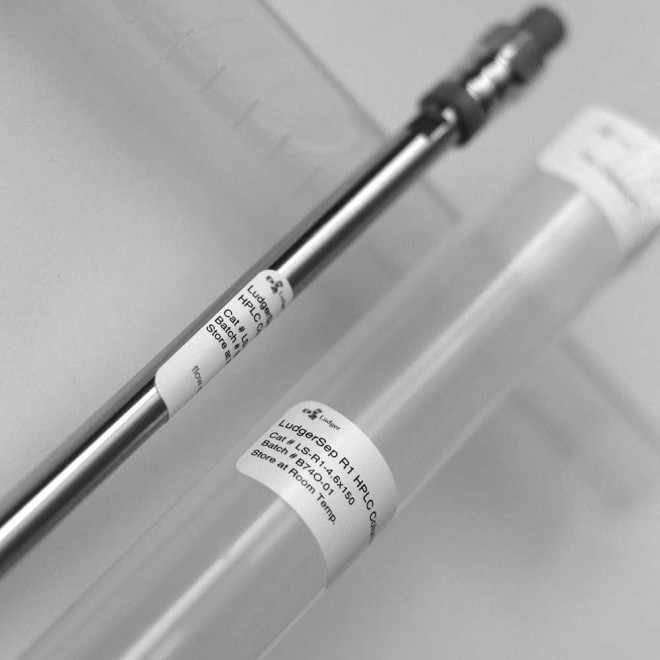LudgerSep R1 HPLC column
Analysis by HPLC of sialic acid variants fluorophore labelled with DMB (1,2-diamino-4,5-methylenedioxybenzene.2HCl) using the LudgerTag DMB Sialic Acid labelling Kit.
Two LudgerSep R1 columns set up in series can be used for analysis of 2AB labelled antibody glycans. This is particularly good for separation of G1, G2, G3 glycan, fucosylated/nonfucosylated glycan separation, bisecting GlcNAc/non-bisecting GlcNAc glycan separation and for separation of MAN5 from neutral complex biantennary glycans.
Product Specifications for LudgerSep™ R1 Column
Application: Analysis of sialic acid variants labelled with DMB (1,2-diamino-4,5 methylenedioxybenzene.2HCl)
Description: The LudgerSep™ R1 HPLC column contains particles with an octadecylsilane coating optimized for hydrophobic chromatography.
Particles: 3 μm silica derivatized with octadecylsiliane coating. 120 Angstrom pore size.
Column size:
| Cat # | Diameter x Length | Column Volume |
|---|---|---|
| LS-R1-4.6x150 | 4.6 x 150 mm | 2.49 ml |
Flow Rates: Typical flow rates = 0.3 to 2.0 mL/min.
Column Pressure: Pressure should not exceed 2000 psi.
pH Range: 2 - 8
Temperature:Typical operating temperature, 30°C, but increasing the temperature may improve resolution for some samples. Temperature range = 15 to 50°C.
Solvents: A typical solvent system for DMB labelled sialic acid analysis uses 7:9:84 methanol:acetonitrile:water as solvent A and acetonitrile as solvent B. Solvents should be degassed. Avoid strong oxidants and anionic detergents.
Column Tube: Stainless steel
Column Protection: It is good practice to install a 0.2 μm in-line filter in front of the column.
Amount of Sample: The maximum amount of glycan sample that can be loaded on the column depends on the number and type of glycan components as well as the nature of any non-glycan material. The typical range for successful analytical runs is 10fmol - 1 nmol per sample peak and up to 200 nmol of total glycans.
Suitable Sample: DMB labelled sialic acids
Sample Preparation: Filter samples, if required, through a 0.2 μm filter. Avoid exposure of DMB labelled samples to light. Dilute samples in water (see LT-KDMB-A1 guide).
Sample Detection: Fluorescence: Excitation: 373 nm, Emission: 448 nm
Handling: Ensure that any glass, plasticware or solvents used are free of glycosidases and environmental carbohydrates. Use powder-free gloves for all sample handling procedures and avoid contamination with environmental carbohydrate.
Safety:Please read the Safety Data Sheets (SDS's) for all chemicals used. All processes involving labelling reagents should be performed using appropriate personal safety protection - eyeglasses, chemically resistant gloves (e.g. nitrile), etc. - and where appropriate in a laboratory fume cupboard
For research use only. Not for human or drug use
HPLC System Requirements
LudgerSep R1 columns can be used with any HPLC pumping system capable of delivering accurate gradients at a flow rate of 0.3 to 2.0 ml/min. In general, systems that mix solvents at high pressure (after the pump head) have lower dead volumes and supply more accurate gradients that are appropriate at the flow rate needed for LudgerSep columns. We recommend keeping sample injection volumes at or below 25 μL, ideally use full loop injection. Although an example chromatogram is shown in this guide, retention times will vary dependent on the HPLC system used.



 Product guide
Product guide